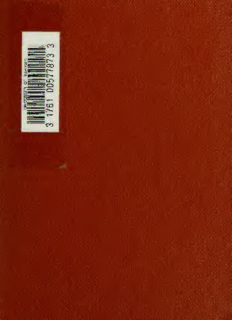
The Greek Anthology - Vol. I of 5 (Loeb Classical Library) PDF
Preview The Greek Anthology - Vol. I of 5 (Loeb Classical Library)
THE LOEB CLASSICAL LIHUARY EDITED ny B.LAPPS,Pu.D.,LL.D. T.B.PAGE, LiiT.U. W. II. D.HOUSE,LiiT.D. THE GREEK ANTHOLOGY I I THE (iREEK ANTHOLOGY. Volume II. SEPULCHRAL EPIGRAMS. THE EPIGRAMS OF SAIXT GREGORY THE THEOLOGIAN. _ Volume III. THE DECLAMATORY EPIGRAMS. VOLUMK IV. THE HORTATORY AND ADMONITORY EPIGRAMS. THE CONVIVIAL AND SATIRICAL EPI- GRAMS. STRATO'S MUSA PUERILIS. Volume V. EPIGRAMS IN VARIOUS METRES. ARITHMETICAL PROBLEMS, RIDDLES, ORACLES. MISCELLANEA. EPIGRAMS OF THE PLANUDEAN ANTHO- LOGY NOT IN THE PALATINE MANU- SCRIPT. //^y/t>/A '-^ ^ THE GREEK ANTHOLOGY WITH AN ENGLISH TRANSLATION BY W. R. PATON IN FIVE VOLUMES I LONDON WILLIAM HEINEMANN : NEW YORK : G. P. PUTNAM S SONS MCMXX 5 4-S^ -. V Firstprinted 1916. Puprinted 1920. PREFACE The Palatine Antliology, so called because it is contained only in the unique manuscript of the Palatine Library at Heidelberg, was composed in the tenth century by Constantine Cephalas. He drew chiefly from three older Anthologies of widely different date : (1) the Stephanus, or Wreath, of Meleager, collected in the beginning of the first century b.c. by this master of the elegiac epigram and comprising all that is most worthy of preserva- tion in these pages. Meleager was a quite unique personality in his own age, and his collection com- ]irises no poems (as far as we know) of that age, except his own.^ It consists ofpoems of the seventh to third centuries b.c.^ i.e. of all the great or classical pferiod of Greek literature. (2) The Ste- phanus of Philippus, made probably in the reign of Augustus. The spirit of poesy had in the interval descended on Italy, rather than on Greece, and here the most Roman poets, such as Crinagoras of Mytilene, arc those who please the most. (3) The Cycle of Agathias, made in the age of Justinian and comprising strictly contemporary work. Tlicre is ^ Antipater of Sidon is however his coiitemporary. ; PREFACE inucli tenderness and beauty in many of the poems, but the writers wrote in a language which they did not command, but by which they were commanded, as all who try to write ancient Greek are. Cephalas included also in addition to the poems drawn from thesemain sources: (1) a certain number ofepigrams derived from well-known authors and a few copied from stones ; (2) the Miisa Puerilis of Strato (Book XII), a collection on a special subject made at an uncertain date^; (3) a collection of Love poems largely by Rufinus (beginning of Book V) (1) the epigrams of the Alexandrian Palladas (fifth centurya.d.).^ At the beginning of each book (from Book V onwards) I try to indicate what is certainly due to each source. In Book IV will be found the proems of the three chief sources that I mention above. Books I-III explain themselves. In the twelfth or thirteenth century, a scholar of astounding industry, Maximus Planudes, to whom learning owes a heavy debt, rearranged and revised the work of Cephalas and to him alone we owe 1 For the sources of tliis book and also of the satirical epigrams of Book XI see the special prefaces to these books. •^ .Some at least of these seem to havebeen incorporated l)y Agathias in hi^ Cycle. It is notneces'^ary to mention herematter included in the Palatine MS. but notreproduced in theprinted texts.
Description: